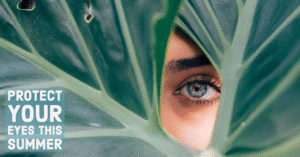Tips for Summer Eye Safety
 Today, June 20, marks the summer solstice, the longest day of the year in 2025 and the astronomical start of summer in the Northern Hemisphere. Despite the enjoyment that can come from warm summer weather—vacations, picnics, holiday parades, swimming, etc., our eyes are particularly vulnerable during this time of year, regardless of the extent of our remaining vision.
Today, June 20, marks the summer solstice, the longest day of the year in 2025 and the astronomical start of summer in the Northern Hemisphere. Despite the enjoyment that can come from warm summer weather—vacations, picnics, holiday parades, swimming, etc., our eyes are particularly vulnerable during this time of year, regardless of the extent of our remaining vision.
The Prevention of Blindness Society of Metropolitan Washington, DC, offers a few practical tips to keep our eyes safe while we have fun in the sun and warmth.
- Wear sunglasses with 100 percent Ultraviolet (UV) Radiation protection. The sun’s rays are known to cause long-term damage to the eyes, leading to issues like cataracts and macular degeneration. Sunglasses are a simple yet effective way to shield our eyes from harmful rays while adding a stylish touch to a summer look. Sunglasses that block 99 to 100 percent of UV radiation ensure maximum protection.
- Wear a hat, which reduces glare and offers additional protection to our eyes. Wide-brimmed hats, in particular, can shield our eyes, face, neck, and ears from harmful UV exposure.
- Wear eye protection when doing yard work such as mowing the lawn, trimming hedges, or working with tools. Protecting our eyes from debris, chemicals, and flying particles is essential. Simple goggles or safety glasses from the local hardware store should be sufficient. Safety goggles are designed to fit over prescription glasses.
- Sunblock is a must, including on the skin around the eyes and in their immediate vicinity.
- Never look directly at the sun, even on cloudy days. Staring directly at the sun can cause severe and lasting retinal damage, even during overcast days since UV rays can penetrate clouds.
- Seek shade during peak sunshine hours, 10:00am-4:00pm. The sun’s UV rays are the most intense during these hours, making it the ideal window of time to take cover and minimize exposure. Legitimate shade is found under a tree, an umbrella, or indoors. It is by far the most effective means for reducing the risk of harmful UV exposure to our eyes and skin.


